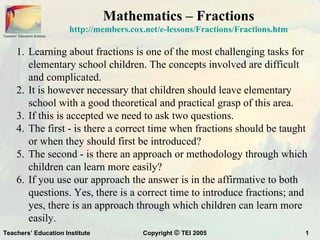Weitere ähnliche Inhalte
Ähnlich wie P fractions (20)
Kürzlich hochgeladen (20)
P fractions
- 1. Mathematics – Fractions
http://members.cox.net/e-lessons/Fractions/Fractions.htm
Teachers’ Education Institute
1. Learning about fractions is one of the most challenging tasks for
elementary school children. The concepts involved are difficult
and complicated.
2. It is however necessary that children should leave elementary
school with a good theoretical and practical grasp of this area.
3. If this is accepted we need to ask two questions.
4. The first - is there a correct time when fractions should be taught
or when they should first be introduced?
5. The second - is there an approach or methodology through which
children can learn more easily?
6. If you use our approach the answer is in the affirmative to both
questions. Yes, there is a correct time to introduce fractions; and
yes, there is an approach through which children can learn more
easily.
Teachers’ Education Institute Copyright © TEI 2005 1
- 2. Mathematics – Fractions
http://members.cox.net/e-lessons/Fractions/Fractions.htm
Teachers’ Education Institute
When should fractions be taught?
2. According our approach it is important to introduce
fractions to children of 9/10.
3. The reasons for this are somewhat complicated and relate
to children’s growth patterns.
4. Children at this age are losing their holistic and
integrated perception of the world. Up until this time
children think globally i.e. they perceive and feel
themselves to be part of the world.
5. They also see the world as a unity. Teaching needs to
relate to this unity and wholeness; indeed an important
element is to convey the idea of totality, a wholeness that
has various parts.
Teachers’ Education Institute Copyright © TEI 2005 2
- 3. Mathematics – Fractions
http://members.cox.net/e-lessons/Fractions/Fractions.htm
Teachers’ Education Institute
1. Between the ages of nine and ten the holistic perceptions become
fragmented.
2. The teaching of fractions (taught from the whole to the parts)
relates to the division and fragmentation of these holistic
perceptions.
3. Consequently, this is the ideal time to introduce “fractions”, for in
this subject area we have the experience of taking the whole to
parts and then reassembling these various parts.
4. Our approach continually advocates that there is a “right time” to
introduce much of the content of different subject areas.
5. This is usually determined by the child’s stage of all-round
development (including emotional, social, psychological and
physical) and not just cognitive growth.
Teachers’ Education Institute Copyright © TEI 2005 3
- 4. Mathematics – Fractions
http://members.cox.net/e-lessons/Fractions/Fractions.htm
Teachers’ Education Institute
1. Our approach differs from conventional approaches in that
decisions regarding when a topic or concept is introduced are
made with regard to far more than just the academic attainment or
intellectual development of children.
2. They are made by taking into account the all-round development
of children.
3. They are also made after asking quite different questions than
those normally asked.
4. The educator might ask the question: “Is this child ready to
handle this content at this particular time?”; whereas the teacher
using our approach would find this question somewhat irrelevant,
and would tend to ask such questions as: “What will help us feed
and enrich this child at this particular stage of development?”
Teachers’ Education Institute Copyright © TEI 2005 4
- 5. Mathematics – Fractions
http://members.cox.net/e-lessons/Fractions/Fractions.htm
Teachers’ Education Institute
How should fractions be taught?
• Children of 7-14 live very much in the world of
feeling.
• Before this, their earlier years have been dominated,
to a great extent, by the “will”; from around 7 the
affective comes to the fore; after puberty the
intellectual activity predominates.
• The elementary school child’s world is also one of
color, and pictorial representation; consequently
approaches such as story-telling, which stimulate
children's imagination, are to be recommended.
Teachers’ Education Institute Copyright © TEI 2005 5
- 6. Mathematics – Fractions
http://members.cox.net/e-lessons/Fractions/Fractions.htm
Teachers’ Education Institute
The sequence in teaching a new concept is usually as follows.
• First Stage: The first stage is to relate material to the experience of the
student. It is accepted that this experience is different from the adults’
experience. In essence children are not miniature adults. When teaching adults
we teach to the “head” whereas for elementary school children we need to
teach to the “heart” and “hands”. Wherever possible content is introduced so
that it relates to artistic and pictorial representation. Through this type of
format information is absorbed in a way that is in empathy with the students’
experience.
• Second Stage: The second stage is to encourage the students to express their
experience through a variety of artistic formats. Some children will want to do
this quickly; others will want to take their time. This stage should not be
hurried and the children should be given enough time to work through a
number of formats according to ability, aptitude and temperament.
• Third Stage: The third stage is to work through concrete examples.
• Fourth Stage: The final stage is to introduce the abstract concepts and to
work symbolically with numbers.
Teachers’ Education Institute Copyright © TEI 2005 6
